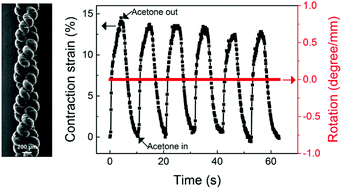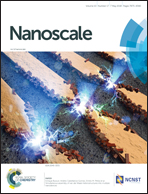Self-plied and twist-stable carbon nanotube yarn artificial muscles driven by organic solvent adsorption†
Abstract
Artificial yarn/fiber muscles have recently attracted considerable interest for various applications. These muscles can provide large-stroke tensile and torsional actuations, resulting from inserted twists. However, tensional tethering of twisted muscles is generally needed to avoid muscle snarling and untwisting. In this paper a carbon nanotube (CNT) yarn muscle that is tethering-free and twist-stable is reported. The yarn muscle is prepared by allowing the self-plying of a coiled CNT yarn. When driven by acetone adsorption, this muscle shows decoupled actuations, which provide fast and reversible ∼13.3% contraction strain against a constant stress corresponding to ∼38 000 times the muscle weight but almost zero torsional strokes. The cycling test shows that the self-plied muscle has very good structural stability and actuation reversibility. Applied joule heating can help increase the desorption of acetone and increase the operation frequency of the self-plied muscle. Furthermore, by controlling the coupling between the joule heating and acetone adsorption/desorption, tensile actuations from negative to positive have been achieved. This twist-stable feature could considerably facilitate the practical applications of such muscle.



 Please wait while we load your content...
Please wait while we load your content...